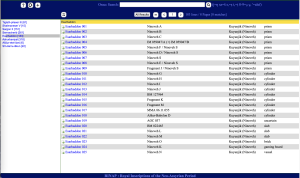1. Exploring Word Meanings, Translations and Other Instances
Let us get started and learn about one of the main features of the RINAP online corpus: word meanings and other instances in which a specific word appears in the Neo-Assyrian royal inscriptions.
> When you head to the Corpus home page, you'll find the inscriptions of King Tiglath Pileser III displayed.
> Simply click on the menu (located on the left) to explore inscriptions from other kings.
Each list of royal inscriptions provides details on where the inscriptions were discovered and the object on which the texts are inscribed.

| kings (use for navigation) |
inscriptions (RINAP references) |
inscriptions (other references) |
provenance | object |
- The video demonstrates the steps described below. Please click on the button located in the right corner to view the video in full-screen.
- > Select an inscription, such as Esarhaddon 001.
On the right, you'll find an English translation. In this case, the translation covers the first seven lines of the cuneiform text. On the left, you'll see each line's transliteration1. - > Click on individual words for more information. You'll discover details like their meaning, translation, written forms (in transliteration), normalized forms (transcription2), and the number of other instances in which the word is used in the Neo-Assyrian royal inscriptions. You can find the number of instances on the right side of the yellow banner.
For instance, consider the phrase tēnû at the end of line 14 (te-nu-u-ka), which originally means 'change (of clothing)'. Here, it's translated as 'replacement' and appears in this form in nine other instances. Click '9 instances' on the right of the yellow banner to explore other passages where tēnû is used. In some cases, a word may have multiple translations depending on the context. Take the word 'bītu' for 'house' (written as the Sumerogram3 É) in line 21. While it's commonly translated as 'house', it's translated as 'temple' in 18 instances and even once as 'room' and 'container'. This word appears frequently in RINAP. You can filter other instances where this word appears by kings.
Now it is your turn: Use the online corpus to answer the following questions.
A Short Introduction to Technical Terms
- A transliteration is a conversion from a foreign script (such as cuneiform) into the Latin alphabet while maintaining the individual characters. For example, a transliteration of a cuneiform text reflects the syllabic characteristics of the Akkadian language. Please click here ↑ to return to the main text.
- A transcription is a conversion from a foreign script (in this case, cuneiform) into the Latin alphabet. The transcription does not represent the syllabic characteristics of the Akkadian language but the composed words. Please click here ↑ to return to the main text.
For example:cuneiform transliteration transcription translation 𒋼𒉡𒌋𒅗 te-nu-u-ka tēnûka your replacement Please note that the suffix (ending) "-ka" adds the possessive determiner "your" to the word.
- A Sumerogram is a cuneiform character (or a group of cuneiform characters) that represents one word instead of a syllable or letter. Hence, it is a specific cuneiform type of logogram (a character that represents one word). In transliteration, it is written in capital letters. Please click here ↑ to return to the main text.
For example:cuneiform transliteration transcription translation 𒂍 É or E2
bītu
house